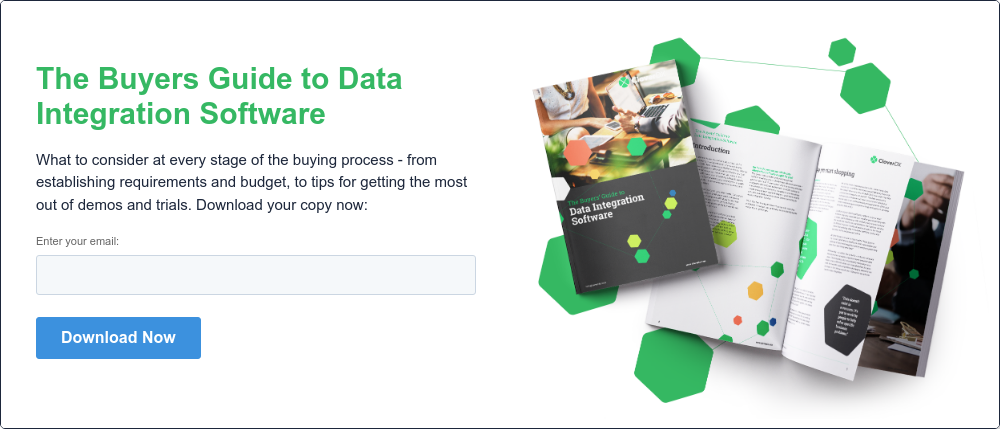Buying any enterprise software is a complex process. Even more so when it comes to data platforms – they're often highly technical, need to integrate with and service virtually every part of the business, and deliver insights to both technical and business users.
Our Buyers Guide offers a roadmap to help you navigate through the process of identifying the vendor that’s right for you.

Phase 1: Requirements and shortlisting
When you kick off your search for a new tool is when you shape the outcome. The more time and effort you put in at the start of your search for a new tool, the more focused and efficient you can be, and the quicker you should be able to narrow down a shortlist of vendors to contact.
And once you start contacting vendors, you'll have better conversations if you have clear requirements.
Having a clear (ideally actually written down) list of what you’re looking for means you can easily share it with multiple vendors, making comparisons more useful.
- Do think about what success looks like. Be clear about the end goal(s) – do you want to move data responsibilities away from expensive technical resource to non-developers, or are you looking for faster turnaround in analysis or onboarding new customers?
- Do think about the details. How many data sources does this solution need to cover? What kind of volumes do you need to handle? Where is the data located? What’s needed to clean, standardize and optimize it?
- Do think about the relationship you want with your vendor. Do you want to do everything yourself, or do you want the option of being able to pick up the phone for help, or have someone guide you through best practices?
- Do think about the future. How are your data needs likely to change over time and as your business grows. Equally important, how are your own team’s resources and capabilities likely to evolve?
- Don’t think licensing is the only cost. ‘Free’ solutions might need you to spend your own time and money on fixing issues. And if the level of support you need is going to be extra, make sure you account for that. Are the features you need all included? What about upgrades?
- Don’t ignore your users. Who is going to be working with your solution? It will affect your purchase decision. Technical users might need a developer-friendly product with more power and flexibility, business users might need self-service interfaces. Understand if you’re making compromises somewhere, and if it’s worth it to you. And make sure the tools on your shortlist will work for all your users.
Request a demo of CloverDX and see how you can automate your data processes, save time, and reduce costs.
"I can't even convey how much of my time is spent following up with vendors who would happily do nothing if not incessantly prompted for status updates. That is never an issue with CloverDX's team. They are the only one that I can give a list of requirements to and simply walk away from. I know that they will always follow through within the agreed time and with a solution built in their product that is so brilliant."
- Data and Analytics Manager, Healthcare and Biotech (Gartner Peer Insights review)
Phase 2: Trials and demos
Product evaluations and vendor demos are both crucial parts of the buying process. Evaluations allow your team to get to grips with how the product works, and test whether it can handle what you need. And demos give you a chance to hear from the experts, and ask them all your questions.
Even the process of going through demos and trials with multiple vendors can help you make your choice – which companies don’t return your calls quickly? Which go above and beyond with sending you relevant and helpful information? Which sound like they know what they’re talking about, and which leave you frustrated?
- Do make sure you’re trialing the full product, not something that has restricted features. And make sure you take the time to actually try and implement a part of your solution with the product (don’t just ‘play around’ with it), so you can really see how it works.
- Do ask for a prolonged trial period if you need. Good vendors should work with you to help achieve your goals and help you understand the product and its capabilities. Putting more effort into a full evaluation might use up some resource now, but will pay off over the long term.
- Do be realistic about your resources and capabilities. Weed out vendors whose services would leave your team or organization overextended or unable to cope.
- Do have a product demo. It’s as much of a chance to assess the vendor’s team as the product. And make sure they’re willing to tailor the demo to your needs.
- Do make sure you understand the licensing model, including any costs for setup or add-on features, and think about it will impact you as your business grows.
- Do look for vendors that will tailor a demo to your specific use case – maybe even using your own test data.
- Don’t be afraid to make vendors work during the demo and evaluation stages. Make sure they can answer all of your questions, provide you with proofs of concept and walk you clearly through every part of their solution.
- Don’t ignore your gut feelings. Does this company seem likely to value your business? Has it shown it will respond promptly when you need it? Does it seem like the kind of business you want to have a relationship with? Or are there nagging doubts the vendor might forget you once the order is signed?
- Don’t be afraid to steer demos away from what the vendor wants to show you, to what you really need to see
- Don’t be afraid to acknowledge when a solution isn’t right for you. Expect the vendor to address your suitability concerns, and watch closely to see how honest they’re being with you. Good vendors should be clear about what their solutions can offer, as well as what caveats to expect.
- Don’t forget about support – make sure you understand what you’ll be getting, and who is providing it (it is the vendor directly, or an outsourced partner, and can they meet your SLAs?)
Phase 3: Implementation
Once you've made your decision and signed the contract, the process isn't over. The implementation phase is arguably the most important, as it’s when you need to make sure the tool is set up to meet your needs and can start delivering the benefits you’ve paid for.
Implementation isn't always straightforward. Technical and culture issues can both create stumbling blocks, but this is another area where your vendor should be able to help you through - they've likely seen it all before and can make the process as smooth as possible for you and your team.
Here's some tips for this final phase (and beyond):
- Do have clear goals and expectations in place as you prepare to implement your software. You should also think about metrics for measuring success. It’s important that everyone involved agrees to these. What’s more, everyone at all levels – from your management to the vendor’s developers – should be clear about the benefits you’re aiming for. This will help to avoid nervousness and headaches during implementation.
- Do expect knock‑on effects after implementation. New insights will open up new opportunities for better working, cost savings and more.
- Do take new opportunities to innovate. As you put your new tools (and new expertise) to use to solve more and more data problems, some ‘out of the box’ thinking can lead to huge benefits. Your vendor should be excited to support you in these new use cases (and not penalize you with charges).
- Don’t neglect people and business culture. Give your employees the training, support and other tools they need to use your new solution from the moment it goes live.
- Don’t be surprised if you encounter resistance from people who are used to doing things differently – for example, from dev teams accustomed to building everything from scratch with scripts and SQLs. Try to maintain a balance between efficiency and transparency throughout this process.
- Don’t underestimate the potential for change. Better data integration can pave the way for future innovation and new technologies, not to mention freeing up people from repetitive data tasks to more valuable work.
- Don’t be afraid to ask your vendor for advice. They’re the experts, and should be able to help point you in the right direction and advise you on the best way to achieve something. Developing a long term relationship with your vendor can also help you get the most out of new features so you can continue learning, and your organization can keep benefiting from your data integration platform.
How Ortec Finance reduced repetitive manual data processes by up to 90% with CloverDX
“We are quite technical in our team, but sometimes you just don’t know the CloverDX specifics. What’s the industry standard way of doing something? What’s the smart way to do it? To address these questions we used CloverDX’s expert on demand during the implementation process. We found it really valuable to be able to speak to someone who has a lot of experience and have them either confirm your thinking or point you in a new direction”
- Thomas Hage, Senior Consultant at Ortec Finance
Put us to the test
We believe that data integration vendors should help make the buying experience as easy and smooth as possible for prospective customers. If you want to see how the CloverDX Data Integration Platform can help you automate and manage your data processes, request a demo and test us out!









